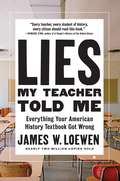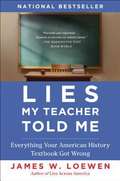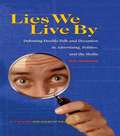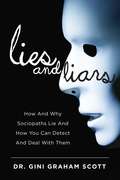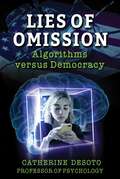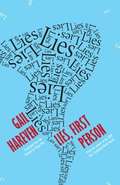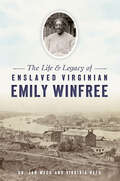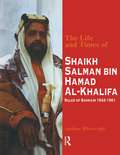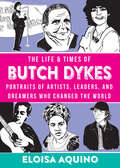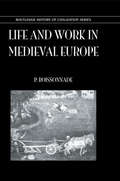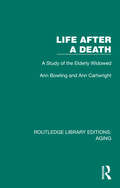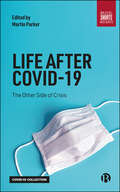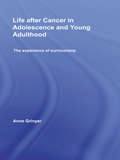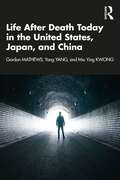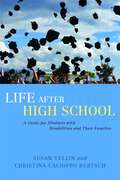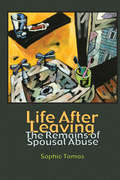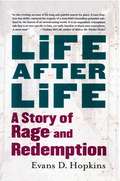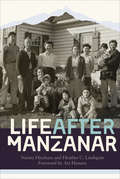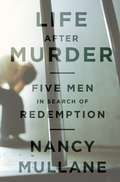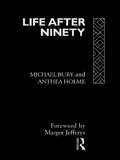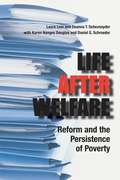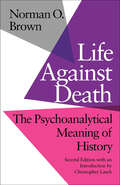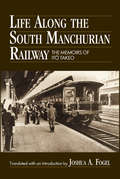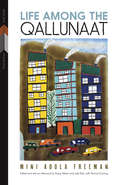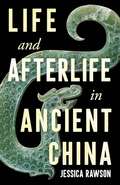- Table View
- List View
Lies My Teacher Told Me: Everything Your American History Textbook Got Wrong
by James W. LoewenSince its first publication in 1995, Lies My Teacher Told Me has become one of the most important - and successful - history books of our time. Having sold over two million copies, the book also won an American Book Award and the Oliver Cromwell Cox Award for Distinguished Anti-Racist Scholarship and was heralded on the front page of the New York Times in the summer of 2006. For this new edition, Loewen has added a new introduction that shows how inadequate history courses in high school help produce adult Americans who think Donald Trump can solve their problems.
Lies My Teacher Told Me: Everything Your American History Textbook Got Wrong (2nd edition)
by James W. LoewenWinner of the American Book Award and the Oliver C. Cox Anti-Racism Award of The American Sociological Association. Americans have lost touch with their history, and in "Lies My Teacher Told Me", Professor James Loewen shows why. After surveying eighteen leading high school American history texts, he has concluded that not one does a decent job of making history interesting or memorable. Marred by an embarrassing combination of blind patriotism, mindless optimism, sheer misinformation, and outright lies, these books omit almost all the ambiguity, passion, conflict, and drama from our past. In this revised edition (with updated material) Loewen explores how historical myths continue to be perpetuated in today's climate and adds an eye-opening chapter on the lies surrounding 9/11 and the Iraq War. From the truth about Columbus's historic voyages to an honest evaluation of our national leaders, Loewen revives our history, restoring the vitality and relevance it truly possesses. Thought provoking, nonpartisan, and often shocking, Loewen unveils the real America in this iconoclastic classic beloved by high school teachers, history buffs, and enlightened citizens across the country.
Lies We Live By: Defeating Doubletalk and Deception in Advertising, Politics, and the Media
by Carl HausmanFirst Published in 2000. Routledge is an imprint of Taylor & Francis, an informa company.
Lies and Liars: How and Why Sociopaths Lie and How You Can Detect and Deal with Them
by Gini Graham ScottApproximately 12 million Americans, or one in twenty-five, are sociopaths. But what does this statistic mean? What exactly is a sociopath? What do they do to be labeled as such? And how many people are affected by them? While everyday lying has become acceptable and even socially necessary, it is often difficult to discover when someone is manipulating you through lies or other actions. Since a sociopath has no conscience, he or she feels no remorse about piling lie on top of lie until, eventually, the façade comes crashing down and he or she is exposed.When Dr. Scott was warned about a film producer she had hired, she confronted the woman, only to be fed explanations and excuses. Eventually, Scott found that she had been the victim of this sociopath for five years, along with many others. In this book, she delves into medical research on sociopaths as well as interviews with sociopaths and victims alike to provide a comprehensive picture of this mental disorder. Lies and Liars also includes information about:The types of lies told by sociopaths in different situationsThe relationships between sociopaths and victimsRecognizing when someone is lyingHow to deal with a suspected or discovered sociopathic liarThe odds are very high that you know a sociopath already, so figure out what signs to look for to prevent yourself or your loved ones being manipulated or harmed.
Lies of Omission: Algorithms versus Democracy
by Catherine DeSotoA lie of omission—withholding needed information to correct a false belief. There is a sharp and more hostile divide emerging in the United States. The shift is documented by various polls, and the speed of the change is alarming. There are certainly contributing factors, but one factor is unique to the contemporary era: receiving the majority of our information via social media experiences. Media algorithms, and to some extent overt censorship, serve users curated content that is unlike what their neighbors receive.Lies of Omission brings together various perspectives on the causes and effects of the divided information streams. Psychology and neuroscience, combined with some historical jurisprudence, are woven together to spell out the dangers of the modern social media experience. Importantly, the human response can be understood as rooted in our psychology and neurochemistry. In part two of the book, eight hot button issues that have provoked deep divisions among American citizens are presented as well-researched, opposing-view chapters with a goal to lay bare the extent of the disinformation gap that we are living in. With the rise of ephemeral smart media, and the associated displacement of the permanently printed word, it is rare to have a clear idea of what persons who do not share our opinions actually believe, or why.The decimation of communal information sources is nearly complete. What can one do? One concrete step is to turn some of your attention away from curated, impermanent news and read a book. Read this book. Dr. Catherine DeSoto spells out why it is worth our time to be informed regarding the issues we care about: something your phone&’s curated media will never do for you. Open your mind to the quaint idea that one is not informed unless one understands the opposing view. Surprising all-new research regarding the political divide and the pandemic is included. Together with over 150 references, this book will be the definitive source documenting the effects of the media algorithm revolution.
Lies, First Person
by Dalya Bilu Gail HarevenFrom the 2010 winner of the Best Translated Book Award comes a harrowing, controversial novel about a woman's revenge, Jewish identity, and how to talk about Adolf Hitler in today's world.Elinor's comfortable life--popular newspaper column, stable marriage, well-adjusted kids--is totally upended when she finds out that her estranged uncle is coming to Jerusalem to give a speech asking forgiveness for his decades-old book, Hitler, First Person.A shocking novel that galvanized the Jewish diaspora, Hitler, First Person was Aaron Gotthilf's attempt to understand--and explain--what it would have been like to be Hitler. As if that wasn't disturbing enough, while writing this controversial novel, Gotthilf stayed in Elinor's parent's house and sexually assaulted her "slow" sister.In the time leading up to Gotthilf's visit, Elinor will relive the reprehensible events of that time so long ago, over and over, compulsively, while building up the courage--and plan--to avenge her sister in the most conclusive way possible: by murdering Gotthilf, her own personal Hilter.Along the way to the inevitable confrontation, Gail Hareven uses an obsessive, circular writing style to raise questions about Elinor's mental state, which in turn makes the reader question the veracity of the supposed memoir that they're reading. Is it possible that Elinor is following in her uncle's writerly footpaths, using a first-person narrative to manipulate the reader into forgiving a horrific crime?Gail Hareven is the author of eleven novels, including The Confessions of Noa Weber, which won both the Sapir Prize for Literature and the Best Translated Book Award.Dalya Bilu is the translator of A.B. Yehoshua, Aharon Appelfeld, and many others.
Life & Legacy of Enslaved Virginian Emily Winfree, The (American Heritage)
by Dr. Jan Meck Virginia RefoLeft destitute after the Civil War by the death of David Winfree, her former master and the father of her children, Emily Winfree underwent unimaginable hardships to keep her family together. Living with them in the tiny cottage he had given her, she worked menial jobs to make ends meet until the children were old enough to contribute. Her sacrifices enabled the successes of many of her descendants. Authors Jan Meck and Virginia Refo tell the true story of this remarkable African American woman who lived through enslavement, war, Reconstruction and Jim Crow in Central Virginia. The book is enriched with copies of many original documents, as well as personal recollections from a great-granddaughter of Emily's. The story concludes with pictures and biographies of some of her descendants.
Life & Times Of Shaikh (English: Ruler of Bahrain 1942-1961
by WheatcroftFirst published in 1995. Routledge is an imprint of Taylor & Francis, an informa company.
Life & Times of Butch Dykes, The: Portraits of Artists, Leaders, and Dreamers Who Changed The World
by Eloisa AquinoPortraits of women throughout history who have defied society's expectations of feminine behavior and appearance in order to live a more authentic life. These short vignettes combine biographical sketches with evocative illustrations for an impact that is as bold, powerful, and inspirational as the brilliant artists, writers, and musicians they represent. The notable people profiled in this book include Audre Lorde (activist and poet), JD Sampson (artist, and musician known for Le Tigre and MAN), Jenny Shimizu (model and actress), Claude Cahun (photographer, performer, and writer who defied all gender expectations and wasn't any gender), Esther Eng (director), Gladys Bentley (singer and performer), Gertrude Stein (author and poet), Martina Navratilova (tennis champion), and Gloria Anzaldúa (scholar). Author and artist Eloisa Aquino presents these icons against heteronormativity in a good-humored homage, showing how the courage to be true to yourself can spark the sort of work that changes the world.
Life & Work In Medieval Europe (The\history Of Civilization Ser.)
by Boissonnade"First Published in 2005, Routledge is an imprint of Taylor & Francis, an informa company."
Life After A Death: A Study of the Elderly Widowed (Routledge Library Editions: Aging)
by Ann Cartwright Ann BowlingThe recently widowed experience many complex problems, and an understanding of their needs and the kinds of difficulties they encounter is essential if appropriate services and help are to be mobilized. It is the old who are most likely to be widowed, and they may face this crisis at a time when they may also be adjusting to ill health and increasing infirmity, and to retirement, with its problems of role identification and adaptation to an increase in leisure and a decrease in wealth. Most will have to learn to live alone, or to uproot themselves from their home and adjust to life with relatives. Often, the elderly person will have been involved in caring for their spouse during his or her terminal illness; widowhood will mean that they have lost their main occupation. For some, who are themselves disabled, widowhood may mean that they have lost the person who cared for them, so that there is an immediate crisis as alternative sources of care need to be found. These problems have to be faced in a situation often complicated by the anxiety, loneliness, apathy, and bewilderment of bereavement.Originally published in 1982, Life After A Death presents the results of a study of the experiences and attitudes of over 350 elderly widowed men and women, their general practitioners, and their relatives, friends, and neighbours, and considers the implications of the help the widowed received, or failed to receive, from those to whom it was most likely that they would turn for support. The authors’ identification and description of the emotional and practical day-to-day needs of the widowed, and their recommendations about the potential role of the general practitioner and voluntary and social services, should be considered by all those concerned to alleviate the difficulties of the widowed, and to help them to live a better ‘life after a death’.
Life After COVID-19: The Other Side of Crisis
by Martin ParkerWhat might the world look like in the aftermath of COVID-19? Almost every aspect of society will change after the pandemic, but if we learn lessons then life can be better. Featuring expert authors from across academia and civil society, this book offers ideas that might put us on alternative paths for positive social change. A rapid intervention into current commentary and debate, Life After COVID-19 looks at a wide range of topical issues including the state, co-operation, work, money, travel and care. It invites us to see the pandemic as a dress rehearsal for the larger problem of climate change, and it provides an opportunity to think about what we can improve and how rapidly we can make changes.
Life After Cancer in Adolescence and Young Adulthood: The Experience of Survivorship
by Anne GrinyerAdolescence and young adulthood is often a difficult enough time without serious illness. However, research has shown that cancer, and surviving cancer, at this age presents distinctive problems medically, socially and psychologically. This important work offers a glimpse into a previously under-researched area and contributes to a better understanding of the needs of young adults post cancer. Focusing not only on the physical effects, but also the social, cognitive, emotional and physiological consequences of surviving cancer in young adulthood, Anne Grinyer draws directly upon data collected from young adults who have been treated for cancer. The book is structured around themes they raised such as fertility; life plans; identity; psychological effects and physical effects. These issues are drawn together in the final chapter and related to clinical and professional practice as well as current policy. This book presents the voices of those who have lived through the experience of cancer in young adulthood, and links them to the theoretical and analytical literature. It will be of interest to professionals and researchers in nursing, social work, counselling and medicine as well as medical sociologists, young adults living with cancer and survivors of young adult cancer.
Life After Death Today in the United States, Japan, and China
by Yang Yang Gordon Mathews Miu Ying KwongThis book is about contemporary senses of life after death in the United States, Japan, and China. By collecting and examining hundreds of interviews with people from all walks of life in these three societies, the book presents and compares personally held beliefs, experiences, and interactions with the concept of life after death. Three major aspects covered by the book Include, but are certainly not limited to, the enduring tradition of Japanese ancestor veneration, China’s transition from state-sponsored materialism to the increasing belief in some form of afterlife, as well as the diversity in senses of, or disbelief in, life after death in the United States. Through these diverse first-hand testimonies the book reveals that underlying these changes in each society there is a shift from collective to individual belief, with people developing their own visions of what may, or may not, happen after death. This book will be valuable reading for students of Anthropology as well as Religious, Cultural, Asian and American Studies. It will also be an impactful resource for professionals such as doctors, nurses, and hospice workers.
Life After High School: A Guide for Students with Disabilities and Their Families
by Susan Yellin Christina Cacioppo Bertsch*Bronze Medal Winner in the Education / Academic / Teaching Category of the 2011 IPPY Awards** Bronze Medal Winner in the 2010 BOTYA Awards Education Category *Graduating high school and moving on to further education or the workplace brings with it a whole new set of challenges, and this is especially true for students with disabilities. This useful book provides a complete overview of the issues such students and their families will need to consider, and outlines the key skills they will need in order to succeed once they get there. The authors describe the legal landscape as it applies to students with disabilities in the USA, and how to obtain the proper disability documentation to ensure that the student receives the right support and accommodations in college. Focusing specifically on the issues that affect students with disabilities, they offer advice on everything from dealing with college entrance exams and the college application process, to selecting the right college, visiting the campus, and achieving medical and financial independence away from home. A list of further resources guides students and their families towards additional sources of information and support, and stories of students with disabilities who have made the transition from high school to further education or the workplace are included throughout. This accessible and thoroughly readable book offers help and support to students with disabilities of all kinds, and their families, both before and during the transition to life after high school.
Life After Leaving: The Remains of Spousal Abuse (Writing Lives: Ethnographic and Autoethnographic Narratives #11)
by Sophie TamasAfter leaving her twelve-year marriage, Sophie Tamas went to the local women's shelter to ask if she had been abused. The result is Life after Leaving, a performative, arts-based journey into the aftermath of spousal abuse and the endless struggle to make sense of loss. We see Sophie's world—the academic lectures, the therapy sessions, the childrearing, the dealings with an ex-spouse, the house reconstruction—as she looks for answers in the literature and in the lives of other women. Both lyrical and theoretical, autoethnographic and analytical, her captivating story builds to a chorus of voices, as her study participants express the loving, longing, pain, hope, and frustration of their experiences after leaving abusive relationships. The text closes with insightful and surprising suggestions for reframing "recovery". An earlier version of this manuscript was short-listed for the AERA Arts-Based Dissertation Award and won the 2011 Outstanding Dissertation Award from the International Institute for Qualitative Methodology. Sponsored by the International Institute for Qualitative Methodology, University of Alberta.
Life After Life: A Story of Rage and Redemption
by Evans D. HopkinsLife After Life is the haunting and gloriously redemptive tale of Evans D. Hopkins's many lives, a sweeping journey from promising middle-class youth to civil rights militant, from criminal and convict to celebrated writer and enlightened man. Evans D. Hopkins was born during the Jim Crow era in a second-rate, segregated hospital, and educated in segregated primary schools in Danville, Virginia, a town that proudly proclaimed itself the "Last Capital of the Confederacy." With parents who stressed the value of education, as a teenager he was in the forefront of desegregation and the Civil Rights Movement. At the same time, he fell in love with the traditionally white man's game of tennis, modeling himself after his idol, the legendary Arthur Ashe, only to be swept off the courts by the Black Panther Party at the age of sixteen. Just out of high school, Hopkins moved to Panther headquarters in Oakland, California, where he spent two years writing for the Party newspaper, covering the trial of the San Quentin Six, working with Party founders Huey Newton and Bobby Seale, and taking part in their move into politics when Seale ran for mayor of Oakland. He became historian for the group, documenting the years when altercations with authorities resulted in the deaths of numerous Panthers. And he was witness to the internal strife within the Party that led to the group's decline and his own decision to leave in the fall of 1974. When he returned to Danville, Hopkins was a different man, disillusioned and filled with rage and a legacy of militancy. He was, in his own words, "the quintessential angry young black man." Convicted of armed robbery and given a life sentence, Hopkins would spend twenty of the next twenty-two years in the prisons of Virginia. Inside, fighting despair and isolation and dreaming of escape, Hopkins sought salvation in the written word, writing in his cell in the early morning hours to escape the noise of the prison. Focusing on issues of social and criminal injustice, Hopkins would begin reaching a national audience when his inside account of an execution, "Who's Afraid of Virginia's Chair," was published in The Washington Post. Paroled in 1997, Hopkins returned home, a free man at last, but facing the overwhelming challenges of caring for his aging parents and daily life in a world that was new after so many years of incarceration. In this stunning look back at a man's struggle with himself and the world around him, Life After Life is also about the influences that sustained Hopkins's development despite overwhelming odds, influences that allowed him to emerge from two decades of imprisonment an uncorrupted man, still able to give to his family and community. Finally, Life After Life is a searingly honest view of events in America in the second half of the 20th century as seen through the eyes of a child, a militant, a prisoner, and, most important, a writer.
Life After Manzanar
by Naomi Hirahara Heather C. Lindquist&“A compelling account of the lives of Japanese and Japanese Americans incarcerated during World War II . . . instructive and moving.&”—Nippon.com From the editor of the award-winning Children of Manzanar, Heather C. Lindquist, and Edgar Award winner Naomi Hirahara comes a nuanced account of the &“Resettlement&”: the relatively unexamined period when ordinary people of Japanese ancestry, having been unjustly imprisoned during World War II, were finally released from custody. Given twenty-five dollars and a one-way bus ticket to make a new life, some ventured east to Denver and Chicago to start over, while others returned to Southern California only to face discrimination and an alarming scarcity of housing and jobs. Hirahara and Lindquist weave new and archival oral histories into an engaging narrative that illuminates the lives of former internees in the postwar era, both in struggle and unlikely triumph. Readers will appreciate the painstaking efforts that rebuilding required and will feel inspired by the activism that led to redress and restitution—and that built a community that even now speaks out against other racist agendas. &“Through this thoughtful story, we see how the harsh realities of the incarceration experience follow real lives, and how Manzanar will sway generations to come. When you finish the last chapter you will demand to read more.&”—Gary Mayeda, national president of the Japanese American Citizens League &“An engaging, well-written telling of how former Manzanar detainees played key roles in remembering and righting the wrong of the World War II incarceration.&”—Tom Ikeda, executive director of Densho
Life After Murder: Five Men in Search of Redemption
by Nancy MullaneOnce a murderer, always a murderer? Or can a murderer be redeemed? Who do they really become after they have served decades in prison? What does it take for a killer to be accepted back into society? What is the chance that he will kill again? Award-winning journalist Nancy Mullane found herself facing these questions when she accepted an assignment to report on the exploding costs of incarceration. But the men she met behind the walls astonished her with their remorse, introspection, determination, and unshakable hope for freedom and forgiveness. Life After Murder is an intimately reported, utterly compelling story of five convicted murderers sentenced to life with the possibility of parole, who discover after decades in prison that their second chance, if it comes at all, is also the challenge of a lifetime. It follows their struggle for redemption, their legal battles to make good on the state’s promise of parole, and the lives they found after so many years inside.
Life After Ninety
by Michael Bury Anthea HolmeIn Life After Ninety Micheal Bury and Anthea Holme have surveyed and interviewed 200 individuals, living at home and in institutions, to examine old age stereotypes and present a unique picture of the health, quality of life, and social circumstances of the very old. Longevity and the factors which promote it are also discussed, and throughout the book the concept of the 'life course' is employed, which brings together the biographical experiences of individuals, and the changing historical circumstances of the twentieth century, through which they have lived.
Life After Welfare
by Laura Lein Deanna T. SchexnayderIn the decade since President Clinton signed the Personal Responsibility and Work Opportunity Reconciliation Act of 1996 into law--amidst promises that it would "end welfare as we know it"--have the reforms ending entitlements and moving toward time limits and work requirements lifted Texas families once living on welfare out of poverty, or merely stricken their names from the administrative rolls?Under welfare reform, Texas has continued with low monthly payments and demanding eligibility criteria. Many families who could receive welfare in other states do not qualify in Texas, and virtually any part-time job makes a family ineligible. In Texas, most families who leave welfare remain in or near poverty, and many are likely to return to the welfare rolls in the future. This compelling work, which follows 179 families after leaving welfare, is set against a backdrop of multiple types of data and econometric modeling. The authors' multi-method approach draws on administrative data from nine programs serving low-income families and a statewide survey of families who have left welfare. Survey data on health problems, transportation needs, and child-care issues shed light on the patterns of employment and welfare use seen in the administrative data. In their lives after welfare, the families chronicled here experience poverty even when employed; a multiplicity of barriers to employment that work to exacerbate one another; and a failing safety net of basic human services as they attempt to sustain low-wage employment.
Life Against Death: The Psychoanalytical Meaning of History
by Norman O. BrownA shocking and extreme interpretation of culture, history, and the father of psychoanalysis. In Life Against Death: The Psychoanalytical Meaning of History, social philosopher Norman O. Brown radically analyzes and critiques the work of Sigmund Freud. Brown attempts to define a non-repressive civilization, draws parallels between psychoanalysis and the theology of Martin Luther, and also examines the revolutionary themes present in western religious thought, such as ideas found in the work of William Blake and Jakob Böhme.&“Life Against Death cannot fail to shock, if it is taken personally; for it is a book which does not aim at eventual reconciliation with the views of common sense. The highest praise one can give to Brown&’s book is that, apart from its all-important attempt to penetrate and further the insights of Freud, it is the first major attempt to formulate an eschatology of immanence in the seventy years since Nietzsche.&” —Susan Sontag&“One of the most interesting and valuable works of our time. Brown&’s contribution to moral thought . . . cannot be overestimated. His book is far-ranging, thoroughgoing, extreme, and shocking. It gives the best interpretation of Freud I know.&” —Lionel Trilling
Life Along the South Manchurian Railroad
by Joshua A. Fogel Ito TakeoAs part of a worldwide movement, nations and multinational groups are trying to reach closure regarding past atrocites and inhumanites, including what happened in Nanking in 1937. The contributors to this book show that these activites are a search for the common causes of human atrocites.
Life Among the Qallunaat (First Voices, First Texts #3)
by Julie Rak Mini Aodla Freeman Keavy Martin Norma DunningLife Among the Qallunaat is the story of Mini Aodla Freeman’s experiences growing up in the Inuit communities of James Bay and her journey in the 1950s from her home to the strange land and stranger customs of the Qallunaat, those living south of the Arctic. Her extraordinary story, sometimes humourous and sometimes heartbreaking, illustrates an Inuit woman’s movement between worlds and ways of understanding. It also provides a clear-eyed record of the changes that swept through Inuit communities in the 1940s and 1950s. Mini Aodla Freeman was born in 1936 on Cape Hope Island in James Bay. At the age of sixteen, she began nurse's training at Ste. Therese School in Fort George, Quebec, and in 1957 she moved to Ottawa to work as a translator for the then Department of Northern Affairs and Natural Resources. Her memoir, Life Among the Qallunaat, was published in 1978 and has been translated into French, German, and Greenlandic. Life Among the Qallunaat is the third book in the First Voices, First Texts series, which publishes lost or under appreciated texts by Indigenous writers. This reissue of Mini Aodla Freeman’s path-breaking work includes new material, an interview with the author, and an afterword by Keavy Martin and Julie Rak, with Norma Dunning.
Life And Afterlife In Ancient China
by Jessica RawsonThe three millennia up to the establishment of the first imperial Qin dynasty in 221 BC cemented many of the distinctive elements of Chinese civilization still in place today: an extraordinarily challenging geography and environment; formidable infrastructure; a society based on the strict hierarchy of the family; a shared written script of characters; a cuisine founded on rice and millet; a material culture of ceramics, bronze, silk, and jade; and a unique concept of the universe, in which ancestors continue to exist alongside the living. Records of these early achievements and their diverse expressions often lie not in written history but in how people marked the end of their lives: their dwellings for the afterlife. Tombs and the treasures within them are almost the only artifacts to survive from Ancient China; their scale and sophistication rivals their equivalents in Ancient Egypt. Jessica Rawson, one of the most eminent Western scholars of China, explores twelve grand tombs―each from a specific historical moment and place―showing how they reveal wider political, dynastic, and cultural developments, culminating in the lavish ambition of the First Emperor's monument, guarded by his army of terracotta warriors. Beautifully illustrated and drawing on the latest archaeological discoveries, Life and Afterlife in Ancient China illuminates a constellation of beliefs about life and death and provides a remarkable new perspective on one of the oldest civilizations in the world.
